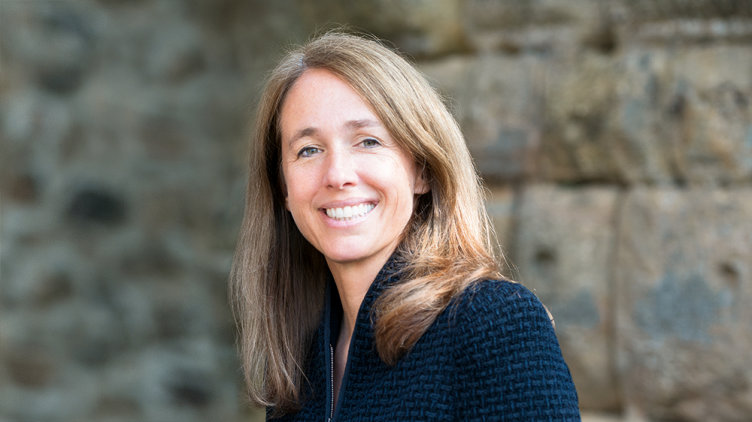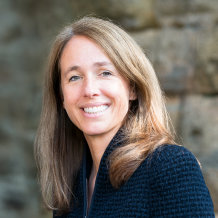(Check against delivery)
Ostfildern, 19 May 2022
Susanne Kunschert: Automation solutions from Pilz: Safe and secure
New railway business unit established: “We are the first choice for a safe, digital infrastructure for railways”
Europe must digitise its entire rail network in the next 10 – 15 years to secure, improve and revolutionise railway operations. This is the only way to achieve higher capacity, greater punctuality, more energy efficiency and thus green mobility! The use of modern, safe and environmentally friendly technologies for railways is thus the path of the future. On the basis of this reasoning, we have repositioned Pilz.
We are taking the next step by establishing an independent rail business unit. Our new business unit combines the global railway activities of Pilz right here in Ostfildern!
We are creating more internal resources for a portfolio and application engineering specially tailored to our railway customers. Additionally, we are designing new digital solutions by merging industrial applications with railway and signal engineering. With our industry-proven automation solutions, we are already fully satisfying the wide-ranging requirements of the rail industry!
Thanks to open interfaces and COTS solutions (commercial off-the-shelf, meaning standardised products), we are hoping to help to dispense with proprietary applications. Automation solutions from Pilz are already used in classic railway applications such as switch controllers or railway crossings, as well as for areas of overlap between industrial and railway applications. This program is supplemented to include railway-specific services in the form of project planning and management, programming, documentation and support during the approval process.
Pilz is a recognised research partner in the European project EULYNX. 13 major European railway infrastructure managers, including Deutsche Bahn, ProRail Niederlande and SSB Schweiz, have joined together under this mantle. The goal is to develop and provide uniform industry standards for new modular signal box technology. We are closely networked with operators, universities and other research partners in this endeavour. Specifically, we are working in a development partnership with ProRail, the largest railway infrastructure manager in the Netherlands. In the project, the safe automation system PSS 4000-R from Pilz is used as the so-called EULYNX adapter. Using this, incoming signals based on the communication protocol RaSTA (Rail Safe Transport Application) can be converted to control commands that can be interpreted by the end device (in this case, the switch). This would be a major step away from local, country-specific solutions and toward an open railway market based on digital train control systems.
Furthermore, we at Pilz will soon be expanding our knowledge in the areas of workplace safety, machinery safety and safety-related assessment in accordance with industrial safety regulations to include plants at railway sites (e.g. in the safety-related inspection and implementation in maintenance and repair halls or in washing facilities for local trains).
Two additional important initiatives from Pilz this year are:
Participation in the InnoTrans trade fair in Berlin in September (20 – 23.09.2022). We will present our innovative solutions to the global industry experts at the world’s largest trade fair for the rail industry.
Active participation in the VDB (Verband der Bahnindustrie Deutschland [German railway industry association]):
We will be presenting our industrial applications and safe solutions here and considering additional potential cooperative partnerships.
Susanne Kunschert
We are making intralogistics safe!
Safe automated guided vehicles (AGVs) may be a basic prerequisite for safe intralogistics applications, but they alone are not enough. Ultimately, the entire application must be considered. With our comprehensive range of solutions, we can address both the manufacturers of safe automated guided vehicles (AGVs) as well as the users.
Pilz supports manufacturers in their path to satisfying the internationally required legal specifications, such as CE marking in Europe, NR-12 in Brazil or OSHA conformity in the USA. We help to implement the specifications from the standard ISO 3691-4, today’s most important international standard for automated guided vehicles and systems, in practice: From the identification of the legal framework, the identification and assessment of hazards, the development of possible measures and assistance during the implementation and verification to supplementing the technical safety measures with any necessary safety information such as labels on the vehicle or notes in the instruction handbooks.
Pilz offers a comprehensive product range for technical protective measures that focuses on sensor technology. This is the sensory organ, so to speak, of the AGV and is used to detect people and objects, their speed and direction of movement. The safety laser scanner PSENscan delivers surface monitoring and the provision of data for the navigation of mobile platforms. PSENscan detects objects in the path of the vehicle and ensures safety, even at high speeds. Up to 70 protected fields enable dynamic protective field modifications when cornering or driving around obstacles. In addition, the safety laser scanner provides the distance data for localisation and navigation. Maps of the environment are thus created for navigation and the AGV can avoid obstacles, for example.
In combination with the modular safety relay myPNOZ and the control and signal devices PITestop and PITsign, we have created a complete solution package for manufacturers of AGVs. The SecurityBridge firewall additionally ensures that no one can access the internal IT network of the mobile platform without authorisation during operation.
Even if the vehicle is safe: It is ultimately the responsibility of the operator to create a safe working environment for use of the AGV in accordance with local occupational health and safety regulations. The following questions must be clarified, among others: What are the structural conditions in the hall? How can possible causes for collisions be minimised in advance? Where are additional protective devices such as safety fences and safety gates needed?
With its service package, Pilz advises and supports users in answering these questions. The offering starts with the development of safety concepts in the design phase and continues up to commissioning, including training. As such it meets the requirements of the standard ISO 3691-4 – also applicable here – and also guarantees productivity in operation.
In the end, safety results from combining the appropriate technology, a normative framework and an understanding of the correct application. This type of holistic approach allows for the perfect harmonisation of safety and productivity.
Susanne Kunschert
Making practical professional development our mission
As my brother mentioned, the same principles apply around the world: namely to create a safe working environment for anyone using and servicing machinery. Legislation, standards and directives alone are not enough; engineers need the necessary competence and a deeper understanding in order to implement machinery safety in compliance with directives and standards. However, in engineering or electrotechnology training, the issue of health and safety is often absent, or covered only briefly. In many cases, engineers can only acquire the necessary knowledge through their own practical experiences. Pilz will help you close this gap in your education.
For Pilz, safety is more than just a product. For this reason, Pilz makes its years of expertise available through a comprehensive services package. Pilz founded the Pilz Academy for the purpose of increasing and sharing this knowledge. The trainers are engineers or technicians with many years of experience in automation technology and machinery safety. All of them, without exception, have practical experience. This is how we make practical professional development our mission!
We have been able to continuously add to the courses offered internationally by the Academy in recent years. In 2021, we trained around 15,000 people in 50 countries with 120 trainers!
When talking about pioneers and standards in industry, one usually thinks only of technology. With our qualification as CMSE, a Certified Machinery Safety Expert, however, we have also broken new ground in the training sector. 10 years ago, there was no special, internationally standardised qualification for machinery safety that is independently certified. In 2013 we introduced our CMSE qualification in four countries – the world’s first certified international professional development for machinery safety. TÜV Nord is our partner. In 2022, there are already 32 countries in which this qualification is offered in 15 languages. Today there are around 9,000 certified experts for machinery safety with this recognised qualification, which appears as a title on business cards and in e-mail signatures.
Our training courses are international and standardised. The latest example here is CEFS – Certified Expert in Functional Safety. We also work together with TÜV Nord here.
The certified qualification as CEFS – Certified Expert in Functional Safety teaches how complex safety systems are designed in compliance with relevant standards. It is practical training that also teaches how such functional safety systems are validated. Training participants who pass the test will receive a certificate. This is recognised worldwide and entitles the bearer to use the title “CEFS – Certified Expert in Functional Safety”.
The need for training and knowledge never ends. Instead, machinery safety requires life-long learning. Our trainers are always up to date on current developments in standards and directives as well as on new technologies.
Susanne Kunschert
Comprehensive industrial security offer from Pilz
In a networked and digitised factory, security is playing an ever-increasing role. The goal here is not only to prevent attacks on production processes for economic reasons. Like my brother said: Security protects safety and safety protects humans.
So Pilz's development is demonstrably secure. And we have products for industrial security in our portfolio, including the SecurityBridge firewall application previously discussed.
Additionally, Pilz is now also expanding its service portfolio in the industrial security sector and thereby supplementing the training courses offered on this topic. Beginning this autumn, there will be a global offer for machine builders and users. With “Industrial Security Services” from Pilz, customers receive a service package that holistically takes into account all aspects of protection of human and machine. A one-stop shop.
How do our customers benefit from this?
First, this ensures the availability of their machinery and system.
Second, the integrity of the data in the machine and the processes and lastly that of the data in the end product is thus guaranteed.
Third, during implementation the responsibility for individual security measures is clearly defined between the machine builder and the user. Everybody knows what they are responsible for!
And finally, our customers receive practical support, as we are personally familiar with the effects of a cyberattack on machinery safety.
What does the offer include?
In the first step, as in the safety sector, we perform a risk assessment. Potential weak points are assessed and the effects of an attack are classified in several levels, from trivial to company-critical. Our experts discuss the result and possible solutions with the customer.
In the second step we create an industrial security concept. The goal here is, among other things, to section networks according to the “zones and conduits” model. This process is described in IEC 62443. The administrative and production networks can be separated in this manner, for example. If necessary, this network can also be segmented, down to the individual manufacturing cells. Workflows for countermeasures are developed and which individual measures are logical is checked – from user authentication and physical protective measures to backing up and restoring data.
After technical implementation by the customer or Pilz, the verification via tests and reviews (with organisational measures) ensures that the concept was implemented in accordance with the specification.
The security assessment by Pilz for plant and machinery supplements the previous safety-related inspection of machines that focused on functional safety in order to achieve a holistic approach to safety and security.

Pilz Automation Ltd
Pilz House, Little Colliers Field
Corby, Northants, NN18 8TJ
United Kingdom
Telephone: +44 1536 460766
E-Mail: sales@pilz.co.uk
Telephone: +44 1536 460766
E-Mail: marketing@pilz.co.uk
